


Cerro Gordo County Iowa
Part of the IaGenWeb Project
|
The Globe Gazette
TEMPLES of WORSHIP $3 Million in New Churches in Mason City
$40,000 in Interest - CHURCH CLEARS WARTIME DEBT
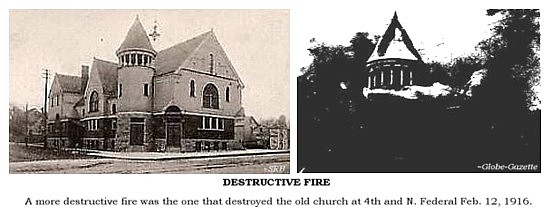
[Section 8, Page 2] The end of a long hard road in wiping out the indebtedness of their church came to the
members of the First Christian Church, 318 Adams N. W., the night of April 12, 1944. That night A. M. Halson, chairman of
the financial department of the church, reported cash and 1944 pledges on hand to liquidate the final installment of debt
which had been saddled on the church upon its erection in 1917. Costs of the church skyrocketed far above earlier expectations
during the World War I period, with the result that the congregation not only had a $130,000 capital expenditure, but also
a $40,000 in interest to pay before the debt was wiped out. It is to the credit of the membership of this church that in
the face of difficulties that at times seem insurmountable, it did not default on a single dollar of debt or interest.
The present church was erected to take the place of a structure, which stood at 4th and N. Federal, which was destroyed by fire Sunday noon, Feb. 12, 1916. The official board was holding a meeting, discussing a coal bill of $300. At the time the board was meeting, the coal they were trying to find a way to pay for was burning, not in the furnace,but in the bin. A few minutes after the board adjourned, firebells rang out and members of the church returned to see their house of worship in flames. The congregation that had been perplexed over the coal bin then rallied to the cause for a new church. A contract was let for what was believed would be an $80,000 building, but mounting costs pushed the cost to $130,000. In 1952, under the pastorate of the Rev. Richard L. Williams, the congregation took another important step in remodeling the sanctuary of the church, The removal of the balcony revealed full length stained glass windows. The ceiling of the sanctuary was lowered two feet, affording a new lighting system, as well as acoustical improvements. The entire front of the sanctuary was redesigned with a new pulpit platform, new baptistery and a new organ console installed.

HOLY FAMILY BUILDS BEAUTIFUL CHURCH
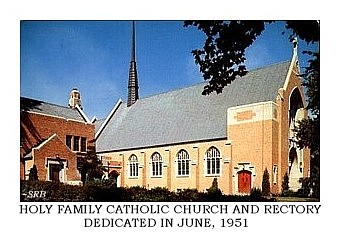
[Section 8, Pages 4 & 10] On Sunday afternoon, July 17, 1947, the Most Rev. Henry P. Rohlman, archbishop of
Dubuque, blessed the site and turned the first spade of sod to start the construction of the large and beautiful
Holy Family Catholic Church and rectory in Mason City. The ceremony took place soon after the arrival to Mason City of the Msgr. A[rthur]. J. Breen to succeed the Msgr. R. P. Murphy, as pastor of the parish. Construction of the church soon got under way and in June, 1951, the completed structure was dedicated. The church and rectory were built in the 700 block on Adams N. W., of brick and stone, harmonizing in color with the parish school across the street. Of Tudor Gothic architecture, the structure contains a number of interesting features. The church proper has five entrances with the main entrance to the east leading to a spacious narthex. The nave is without columns with a clear width of 53 feet and length of 92 feet, terminating in the west end with a chancel framed in a molded stone arch frame.
Floors throughout the nave and narthex are of terrazzo in contrasting and harmonizing colors. The ceiling of the nave features exposed wood trusses and cross beams finished in natural weather oak. The altar is of Botticino marble with a frontal insert panel of Onice marble and the monogram in Florentine mosaic. The reredos, including the oakwood cross and hand-carved basswood corpus, is finished in natural color. About the sanctuary is an oak stained wainscoating. There are marble side altars to match the main altar.
A significant part of the contributions was a $60,000 legacy to the church provided in the will of the late P. W. Corcoran. L. R. Boomhower, trustee of the estate, made the payment Nov. 13, 1945, in accordance with an order issued by Judge M. H. Kepler in district court. The legacy was provided under the will of Mr. Corcoran, a Mason Cityan who left the money to the church of which he was a member. The check was turned over to D. H. Fitzpatrick, attorney for the church, and J. P. McGuire of the church's financial committee.
NOTE: Rt. Rev. Richard P. Murphy was born in Scipio Center, New York, on January 5, 1876, the
son of William and Ellen (Flynn) Murphy. He
graduated with the spring class of 1898, St. Joseph's College (now Lora College), Dubuque, Iowa. Ordained
in 1901, he said his first mass on December 27, 1901 at Mason City. Msgr. Murphy served 31 years at Holy Family Catholic
Church, Mason City, then served at St. Mary's in Corwith, Iowa. He became a Monsignor in 1946. During his time at Mason
City, the Holy Family Catholic Church and school (in 1926) were built. Msgr. Murphy died on March 10, 1958. Masses were
said in Independence and Winthrop. He was interred at St. John's Cemetery, Independence, Iowa. It had been said that
there were two saints who lived at Holy Family rectory - Msgr. Murphy and his St. Bernard dog, Bruno.
OPEN BIBLE CHURCH
[Section 8, Page 4]
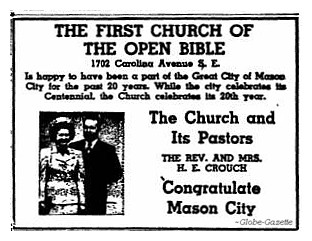
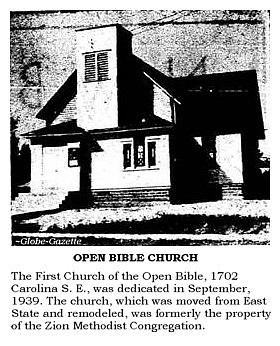
ST. JOSEPH'S CATHOLIC CHURCH
[Section 8, Page 5]
NOTE:
St. Joseph's Catholic Church, Mason City's third religious organization, was established in 1864. A small frame building with a
foundation of rocks was completed in 1873 at a cost of $2,000, located on the site of the present structure.
By 1899, the congregation had outgrown the church, and, with the arrival of Father Michael Carolan, plans were begun for
building a new church, completed in 1901. In the meantime, St. Francis Academy was completed in 1890, destroyed by fire in 1908, and rebuilt
with essentially the same architecture, opening in September of 1910 as St. Joseph's Academy. St. Joseph's and the Holy Family Catholic Churches
merged in 2012. As of June 2013 St. Joseph Catholic Church and Holy Family Catholic Church were organized as Epiphany Parish.
DISTRICT OFFICE OF LUTHERANS HERE
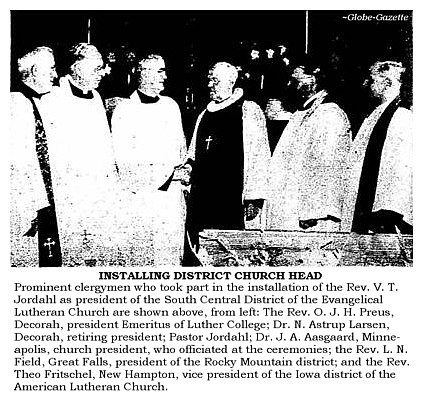
[Section 8, Page 6] The dedication of the $365,000 Trinity Lutheran Church in Mason City June 18, 1950,
marked the fulfillment of a longtime dream and the opening of new possibilities to thousands of Lutherans in this area.
The dedication marked the completion of the first new church the congregation had had since the erection of a small structure
on Pennsylvania S.E. in 1893. It marked the amazing fruition of seven years of leadership of the Rev. Alvin N. Rogness as
pastor. But, as pointed out by Dr. J. A. Aasgaard, president of the Evangelical Lutheran Church, the completion of the church meant the establishment in Mason City of the headquarters for the south central district of the church with the Rev. V. T. Jordahl, district president, having his office in the new church. The district comprises all of Iowa and several states southward as far as Texas, with a heavy concentration of the membership in this area. Installation service for the new president took place in the church in the afternoon in charge of President Aasgaard with many distinguished clergymen from this area and from other parts of the country taking part. Pastor Jordahl's district comprises 70,000 church members.
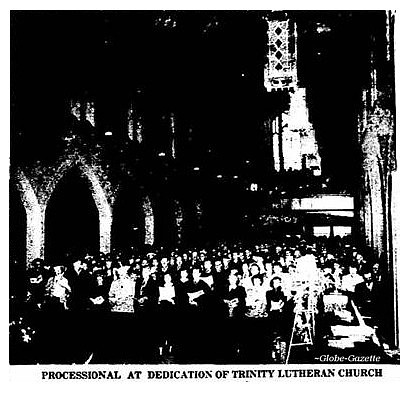
Construction of the new church began with a ground breaking ceremony May 23, 1948. Handling the shovel for this ceremony was Ralph Nelson, son of Gust Nelson, one of the charter members when the Trinity congregation was organized in 1871. Also participating in the ceremony was Dr. Lloyd Gustafson of the First Methodist Church, president of the Ministerial Association. The launching of the construction was the culmination of a five year campaign to raise funds.
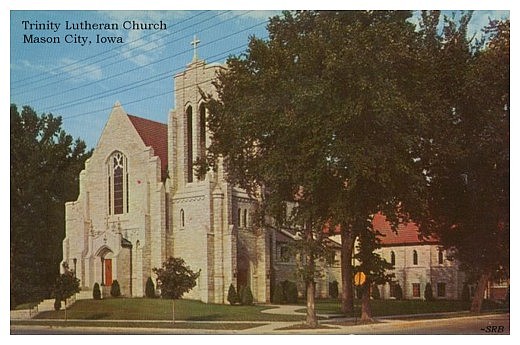
NOTE: Rev. Verner Trygve Jordahl was born in Minnesota on October 26, 1898, and died September
24, 1984. His wife, Norma (Johnson) Jordahl, was born in Ridgeway, Iowa, August 28, 1899, and died December 18, 1992. They
were interred at Madison Cemetery, Winneshiek County, Iowa.
MERCY HOSPITAL BUILT IN 1915
[Section 8, Page 6] It is largely through the teachings of the church that such institutions as the
St. Joseph's Mercy Hospital in Mason City have developed. The initial building of the Mercy Hospital provided 120 beds.
It was opened Dec. 9, 1915, by Sisters from the Motherhouse in Dubuque, Mother Agnes coming with Sister Mary Vitalis,
Sister Mary Catherine and Sister Mary Stanislaus. The school of nursing was opened Sept. 27, 1916, in charge of
Sister Mary Thaddeus. The first graduation was held Dec. 12, 1918. The hospital has added to its equipment through
the years. The nurses residence and educational building was erected in 1925. A new wing was added to the hospital
in 1941, increasing the capacity to 211 patient beds and 54 new borns.
IMMANUEL LUTHERAN WAS BUILT IN 1923
The Immanuel congregation was organized Aug. 20, 1914, under
the leadership of the Rev. S. H. Newman of Burnside. Until the present church was built the congregation worshipped (sic)
in a small chapel. Pastors who have served the congregation have included the Rev. T. A. Conrad, the Rev. B. T. Erholm
and the Rev. Ernest A. Bergeson. At present [1953] the Rev. S. E. Peterson is pastor. NOTE:
Rev. O. A. Elmquist was the pastor at Odgen, arriving there with his new bride in October of1903. On June 5, 1907, he became
the pastor of the Swedish Lutheran Church of Chariton, Iowa, for two years there.
ADAS ISRAEL SYNAGOGUE
[Section 8, Pages 6 & 10] The construction of the Adas Israel Synagogue at 7th and Adams N. W. in early 1942
brought the fulfillment of the dream of members of this congregation since the first Jewish families came to Mason
City a half century ago. The church seats 300, with a spacious social room in the basement.
LUTHERAN CHURCHES
[Section 8, Page 7]
FIRST METHODIST HAS COLONIAL DESIGN
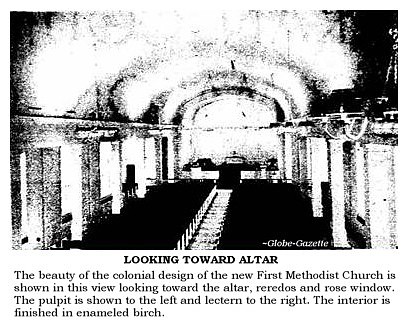
Of
colonial design, the structure includes, besides the main church, an educational wing with administrative offices and a
large social hall and kitchen in the basement. Built of brick, the main body of the church is finished in white enamel,
after pure colonial style. Paneled walls, beam work and pilasters mark the entrance and stairway to the balcony. A block
terrazzo floor in the entrance adds richness to the simplicity of the design.
Walls of the nave are enameled white with plaster run cornices. Each window is equipped with heating and ventilating openings. Pews, with white enameled ends, are of stained walnut. Overall dimensions of the building are 211 feet by 161 feet. The spire is 115 feet to the top of the cross. The completion of this magnificent structure is the climax of nearly a century of service to this community on the part of the First Methodist Church. The first gatherings that blossomed into the organization of a congregation were held in March, 1857. The first pastor as the Rev. Mr. Freemen. The first services were held in the John McMillin home.
The first church built by the congregation in 1870 stood on the present [1953] site of the Piggly Wiggly store and was completed at a cost of $8,000. Following a revival in 1893-94 the old stone church on Washington and 2nd N. W. was built. Original plans were for a $29,000 building. Congregation raised $30,000 and on March 10, 1895, the new church was dedicated by Rev. B. I. Ives of Auburn, N.Y. At the close of the service a financial statement was presented showing the church had cost in excess of $40,000 and Pastor Ives succeeded in getting $15,000 in additional contributions. The site of the new church was acquired in 1949 and the ground breaking ceremony held May 13, 1951. The cornerstone was laid the following Oct. 14. Still to be erected [1953] is a chapel on the north end of the church, for which $25,000 was bequested by the B. C. Way estate and $500 from an anonymous giver.
DEPRESSION DELAYED FIRST CHURCH HERE
[Section 8, Page 8] Elisha Randall, the man who built Mason City's first industrial enterprise - a saw
and grist mill near the present [1953] site of the Jacob E. Decker and Sons plant - was a prominent figure in the organization
of the First Methodist Church. Records show organization took place March 3, 1857, three years after the arrival of
the first families. The charter members were Mr. and Mrs. Randall and daughter, Mrs. J. B. Long, Mrs. George Brentner,
Mr. and Mrs. Timothy Parker, Mr. and Mrs. N. M. Adams and Mr. and Mrs. Alfred Taylor. The first quarterly meeting was
held March 15, 1857. The congregation held services for some time in the upper story of John McMillin's store and later
at the school hours. In 1872 a church was built on the site of the present [1953] Piggly Wiggly store north of Central
Park. In the midst of the building program, the Great Depression of the early 70's came, crippling the booming business
life of the community and nipping a boom that blossomed with the coming of the first railroad in the fall of 1869.
Members of the congregation decided to suspend completion of the church and put a roof over the basement. Services were
held in this basement until a campaign for funds made it possible to complete the church two years later. The basement
was divided into three classrooms. The church had a seating capacity of 400. This church had the first pipe organ in
Mason City. This pipe organ was for a number of years the center of interest for musical minded Mason Cityans. It was
installed by L. L. Huntley, graduate of the Boston Conservatory of Music.
ST. JOHN'S BAPTIST CHURCH

[Section 8, Page 8] in 1936 the St. John' Baptist Church was built at 715 6th S. W. Eight years later in an
impressive ceremony the congregation burned the mortgage, wiping out the last of a $10,000 debt.
ALLIANCE GOSPEL TABERNACLE 616 N. Delaware
[Section 8, Page 8] Organized by Rev. Herbert Sprole following tent meetings held in 1923.
NEW METHODIST CHURCH ON HISTORIC SCHOOL SITE
The north corner of the church property was then acquired by the First Wesleyan Methodist
Church for $800 with a $100 down payment. This group lost the property on foreclosure and the corner was acquired by
C. H. Hughes, who built a house on the lot. In 1891 the house was purchased by C. Currie, father of Frank R. Currie of the
Currie Hardware Store. In 1906 the house was purchased by W. A. Brandenburg, high school superintendent and later
president of Kansas Teachers College at Pittsburg, Kan. The west part of the lot was deeded to Dr. G. C. Stockman, who
built the Frank Lloyd Wright planned house, which still stands adjacent to the church. This house was later sold to Joe
Laird and finally to the present [1953] occupant, Tom Skarlis. Brandenburg sold the corner house to W. H. Boyd,
father of W. W. Boyd in 1910. The church acquired the corner from W. W. Boyd in 1949, thus possessing again the
property it lost three-quarters of a century before. The south corner occupied by the new church also has an
interesting history, as do most of the properties that go back to pioneer days. Charles Gracey of New York, here briefly
as right of way agent for construction of the Austin branch of the Milwaukee, held the property for several years after
he purchased it in 1868. Gracey had a part in platting the town of Plymouth. In 1882, Edmund Pennington, Milwaukee
division superintendent, bought the lot and built the large house that stood on the corner when the church purchased
the property. In 1885 the house was deeded to Mrs. Mary Emsley, widow of Tom Emsley, founder of the First National Bank,
and it was from her heirs, Doris Markley and the late Mrs. H. D. Page, that the property was purchased.
NOTE: William Aaron "Prexy" Brandenburg was born in Clayton County, Iowa, October 10, 1869, the son of Francis Marion
and Enfield (Maxwell) Brandenburg. A 1900 graduate of Drake University, he taught at Drake during summer terms of 1903, 1904,
and 1905 until he came to Mason City in 1905 to accept the position
as superintendent of the public school system. He held this position until 1910. From Mason City, he went to Oklahoma
City as superintendent of public schools, and in August of 1913, without formal application, assumed the presidency
of the State Manual Traning Normal School, Pittsburg, Kansas. He married Miss Altana Adelaide "Alta" Penfield on June 22, 1893, Volga, Iowa.
Miss Penfield was the daughter of William A. and Lucy A. (Chapman) Penfield. William died October 29, 1940, Richmond Heights,
Missouri. Alta was born in Volga, Iowa, on July 26, 1869, and died January 24, 1956, Pittsburg, Kansas. They were
interred at Highland Park Cemetery, Pittsburg, Kansas.
FIRST ST. JOSEPH'S CHURCH
[Section 8, Page 9] The original St. Joseph's Catholic Church, which stood on approximately the
same site as the present building, was 30 by 50 feet in size, with a gallery. It had a seating capacity of 400.
ST. JAMES IN NEW CHURCH
The church is a combination of the forceful,
smooth lines of modernity and the traditions of Christianity, developed over the centuries. Dominating the exterior and
lending unity to the structure is the 107 foot high tower which is crowned by the symbol of Christianity - a cross.
The completed plans call for four units plus a parsonage. Completed thus far is the church proper, the administrative
offices and part of the educational unit. An addition to the plant, for which the foundation has already been laid, will
complete the educational unit and provide the fellowship hall. Entrance to the church building is through a spacious tower entrance and parthex. The nave has side walls 28 1/2 feet tall, pierced with six pairs of lancet windows filled with leaded stain glass in modernistic pattern. Walls of the nave are painted a Caribbean blue and the walls of the chancel are done in a lighter shade of the same color. Pews and chancel furniture have a light finish that blends harmoniously with the surroundings. Above the altar is an exquisite rose window through which filter light and color in surpassing beauty. The baptismal font is placed at the foot of the chancel steps. Simple wood beams and trusses support the semi-flat roof. A structural acoustical material is used between wood trusses and beams serving a dual purpose of support and sound treatment. To the left of the chancel are the organ and organ console, to the right the organ pipes, sacristy and working sacristy. At the rear of the nave and above the low roof of the narthex is a stained glass window area consisting of 15 symbolic plaques depicting the life of Christ. A spacious parlor with fireplace and kitchen are located off the narthex directly behind the nave.
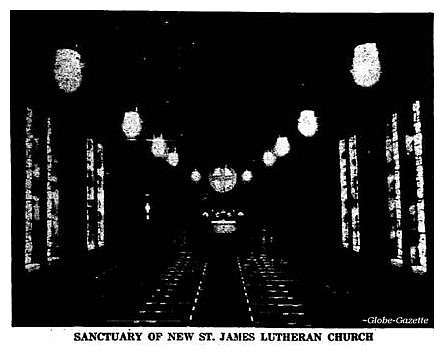

FIRST COVENANT CHURCH
[Section 8, Page 9]
SEVENTH-DAY ADVENTIST CHURCH
[Section 8, Page 9]
NOTE: The church is the site of present-day [2014] New Life Tabernacle United Pentecostal
Church of Mason City. Mason City Seventh Day Adventist Church is now located at 815 N. Kentucky Avenue.
FIRST CHRISTIAN CHURCH
[Section 8, Page 9]
YW PIONEERED IN COMMUNITY ENTERPRISES
[Section 8, Page 10]
C. H. McNider, chairman of the construction committee, is shown above taking the first shovelful of sod to start the excavation for the construction of the Mason City YMCA in 1925. Shown with him from left are other members of the committee and board: George S. Marty, Dr. George M. Crabb, W. S. Wilcox, Henry J. Steinberg, C. G. Maudsley, William H. Hathorn, J. A. Van Ness, Frank J. Hanlon and Secretary C. E. Gilman. The building was dedicated free of debt Dec. 11, 1927. Because of the insufficiency of funds the third floor was never finished. With a bequest of $50,000 from the estate of B. C. Way, it will now be possible to complete the building, work on which is expected to start in a short time, adding to the dormitory rooms in the building. Two Mason City women, Miss Gertrude Decker and Mrs. Gertrude Albert, with the experience of College Y, were instrumental in organizing the local Association and setting it up to conform to the policies and purpose of the great National and International Young Women's Christian Association. In 1912, there were 900 girls employed in Mason City and living elsewhere who needed a place for recreation and fellowship. Since the needs of a community determine the program of an Association, the local YWCA has provided a constantly changing program from that time to the present, to meet the needs of this community. Miss Margaret O'Connor, secretary of the North Central Field, was brought to Mason City in October, 1912, to consider the organization of a YWCA. An organization meeting was held on May 13, 1913, in the Baptist Church. A full Board of Directors was named; a constitution and by-laws written and a motion passed to affiliate with the National association. The location committee reported two available locations; the finance committee reported $3,071.00 on hand; the membership committee reported 454 members. On May 14, the Board of Directors, with Miss O'Connor presiding, elected the following officers: President, Mrs. Gertrude Albert; vice president, Mrs. Dora Holman; corresponding secretary, Mrs. J. G. Melson; recording secretary, Miss Georgia Hanford; and, treasurer, Mrs. Etta Storer. An executive committee, composed of Miss Anna Stanbery, Miss Gertrude Decker and Mrs. J. W. Adams, was named. A Board of Trustees was composed of Jay E. Decker, C. H. McNider, Charles Damon, Mrs. James E. Blythe and Mrs. Elsham. A motion was made to ask the YWCA field committee to send a trained General Secretary to Mason City. The boards of directors and trustees on May 20 decided to purchase the H. I. Smith residence at the southwest corner of State and Adams for $12,000. That YWCA home was formally opened Sept. 24, with about 400 women and girls attending. Board members were hostesses, an orchestra provided music and refreshments were served. Mrs. Albert introduced Miss Howard, general secretary, and Miss Rohr, cafeteria director. The next noon the cafeteria opened. For some time, volunteers helped prepare and serve food, attend the cash register and act as hostesses during meal time. Soon the expression "we need more room" was heard on all sides. By 1916 the membership was 1,035 and plans for enlarging the building was considered. "Move the present building to the back of the lot, erect a new building that will be adequate for years to come and do not sell an inch of the ground for Mason City is growing and has a promising future," was the advice of the trustees. It was voted to put on a campaign to raise $75,000.

The Ministerial Association, Chamber of Commerce, and many local businessmen and women gave endorsement to "The greatest civic project that has ever come before the people of Mason City." The building committee consisted of Mrs. Anna Patton, Mrs. J. W. Adams, Miss Gertrude Decker, Mrs. C. H. McNider, E. L. Balz and Jay E. Decker, with Mrs. Ralph S. Stanbery as treasurer. Plans were drawn and the contract let for a building with a regulation sized swimming pool, the first in Mason City, a gymnasium, cafeteria, reception rooms, offices, club and class rooms. The estimate of $75,00 was not sufficient and $40,000 in bonds were issued. On Nov. 21, 1918, the new building was opened. In 1928, a drive to raise funds to wipe out all debts and provide two years running expenses was over-subscribed by $1,000. Projects in which the local YWCA pioneered until such time as other organizations were ready to take over are: A camping program for girls; Community concerts or lyceums for adults; Stay at home camp, the forerunner of summer playground programs; Adult education classes and garden clubs in 1935; The sunrise Easter service, a combined program of the YMCA and YWCA; A Thanksgiving Hymn service in 1939.
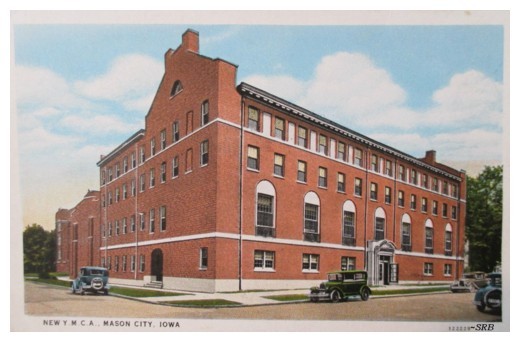
NOTE: George S. Marty Sr. was born September 4, 1891, and died December 12, 1975, interment
made at Memorial Park Cemetery.
CENTRAL LUTHERAN

[Section 8, Page 10] First place of worship to be complete in the city's recent large church building
program was the Central Lutheran, the interior of which is shown above with the Rev. Marvin O. Lee at the altar.
NOTE: Central Lutheran Church was organized in 1927, the first services held at the Chamber of
Commerce rooms. Ground breaking for the church was celebrated on October 14, 1927 and the basement portion was
dedicated on March 25, 1928. The basement portion served the congregation and as the foundation of the superstructure
as it was being constructed and later dedicated on April 16, 1950. Central Lutheran Church and Immanuel Lutheran Church merged on June 3, 1962, becoming
Saint Paul Lutheran Church. All movable contents that could be used, including the Wicks Memorial Pipe Organ, was moved into
the Central Lutheran building, located at 329 East State Street. The Immanuel Church and parsonage were rented out but
eventually sold. Ground breaking ceremonies for a new Educational Unit was observed on September 6, 1964, and dedication
services for the structure was held on Sunday, May 16, 1965. During this time the chancel area was enlarged to accommodate
a free-standing altar with more kneeling area. SOURCE: stpaulmc.com
FIRST CONGREGATIONAL CHURCH

[Section 8, Pages 10 & 13] NEW CONGREGATIONAL CHURCH CHANCEL - One of the outstanding remodeling
projects among churches in the last five years is that of the First Congregational Church, which dedicated a new chancel
and other improvements on the occasion of the 90th anniversary of the congregation May 30, 1948. The picture at
right shows the divided chancel and beautiful rose window. Other improvements included a private prayer chapel.
WESLEY DOUBLES SIZE OF SANCTUARY
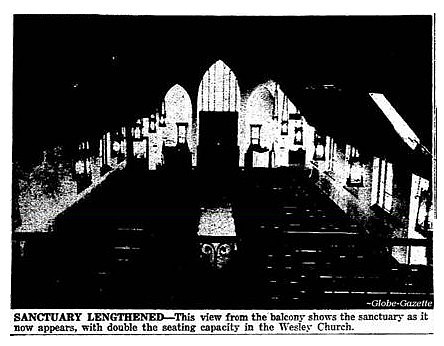
[Section 8, Page 11] The Wesley Methodist Congregation has doubled the size of the sanctuary of the
church, which it erected a little more than a decade ago. The addition, which is 41 by 46 feet, increases the seating
capacity to 600, while the fellowship hall is enlarged to seat 280 persons. The new construction, which was completed
for dedication April 26, includes the enlarging of the kitchen, additional class rooms and social room. The A. J. Thomas
Memorial Chapel was also added, with a seating capacity of 53. The Wesley Church, a merger of the Olivet and Zion
Methodist churches in 1936, broke the ground for its first building May 19, 1940. It was dedicated free of debt Nov.
24, 1940. On May 18, 1952, ground was broken for the new addition. This entire church building program has been
carried out under the pastorate of Dr. Paul Peterson, who has been here since 1940.
[Section 8, Page 11] The Olivet Methodist Church, built in 1913 at 20th and S. Federal, was part of the efforts of the
First Methodist Church to provide places of worship in the outlying areas. in 1915 Olivet was organized with its own
minister. Later it was merged with the Zion Methodist to form the present Wesley Methodist Church.
[Section 8, Page 11] The Rev. William L. Estabrook, who came to Mason City as rector of St. John's
Episcopal Church in 1882, was not only a theologian, but also a physician. In the Civil War he served as both chaplain
and surgeon for the 15th Iowa Regiment and later chaplain and surgeon of other regiments. Estabrook was born [January 24, 1827] in New Brunswick and received his medical degree at Philadelphia College in 1847. In 1849 he went
to California and southward around Cape Horn as surgeon and part owner of the vessel. In 1852 he settled at Loch Haven, Pa.,
and engaged in the practice of medicine. In 1855 he went to Albany, N. Y., and two years later came west to Clinton, Iowa.
In 1961 he was received as deacon in the Episcopal church and began his service with the 15th Iowa Regiment. In 1863 he was appointed by Gen. Grant as chaplain of all the regiments at Memphis, Tenn.,
and was afterwards appointed chaplain at Keokuk. In 1864 he was commissioned surgeon of the 45th Regiment, Iowa Volunteer
Infantry, with the rank of major, serving until the close of the war. In 1867, Estabrook was ordained a priest by Bishop
Lee of Davenport and continued to serve churches in Iowa, coming to Mason City in 1882.
[Section 8, Page 11] BUILT IN 1930 - St. John's Episcopal parish in 1930 erected this beautiful
church. The building is of Gothic architecture constructed after the pattern of the early English village church. This
parish has been a part of the religious life of Mason City since 1871.
[Section 8, Page 11] Shown above is an interior front view of the Union Memorial Methodist Church, 610 4th N.E.
[Section 8, Pages 11 & 14]
Dedication of the Assembly of God Church (shown above left), 1615 Delaware N. E., took place Labor Day, Sept. 2, 1946. The building,
built by the Methodists to serve the factory workers in the north end of the city was later owned by the Lutherans, who
sold it in January, 1946, to the Assembly of God.
HELLENIC ORTHODOX CHURCH
[Section 8, Pages 11 & 14] One of the city's beautiful new churches is that of Hellenic Orthodox Congregation
at Pierce and 2nd S. W., built at a cost of $150,000. The church, of modern colonial design, retains the traditions of
this ancient church as the interior view shows. The new structure takes the place of a church built in 1915 at 14th and
Washington N. W. by newly arrived members of that faith.
BETHLEHEM LUTHERAN CHURCH DEDICATED
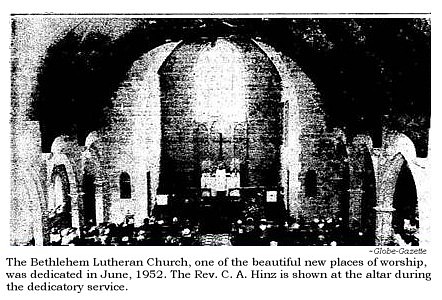
[Section 8, Page 11] The church of Gothic design and built of Lannon stone with Bedford trimstone, is a
monument to [the] leadership of the Rev. C. A. Hinz, who came to the congregation in 1925. In 1928 the church site, between
4th and 5th on Delaware N. E., was procured and a small church building moved on to it and dedicated the same year.
In the years that followed the congregation grew and in 1946 resolved to build a new church. The building committee,
named Feb. 12 of that year, consisted of Robert Heimbuch, Elmer Lutz, Elmer A. Musgjerd, Fred Groh, John Eberhardt, Donald
Sueflow and the pastor, as chairman. On Oct. 19, 1947, the architect's plans were presented, but the congregation decided
to wait until prices would recede. But the expected price reduction failed to develop and on Dec. 14, 1949, the
congregation resolved to proceed with the plans to build. The ground breaking ceremonies were held Nov. 12, 1950, and
the cornerstone was laid April 8, 1951.
FREE METHODIST CHURCH
[Section 8, Pages 11 & 15]
30 YEARS OF PEOPLE HELPING PEOPLE THROUGH YOUR COMMUNITY CHEST
[Section 8, Page 12]
THE YMCA - Has grown with Mason City and joins in the celebration of the city's centennial observance.
With service to boys as a byword, the YMCA stressed participation for everyone. Physical activity, crafts, education
and fellowship make the YMCA a focal point in the lives of all Mason Cityans. We look to the future with the same
confidence with which he can point to the past. PUBLIC HEALTH NURSING ASSOCIATION - The skilled nursing
care give by your Public Health nurses has kept pace with the growth and needs of Mason City. The Public Health
Nursing Association has given skilled nursing care and taught healthful living for over thirty years. Organized
by the Women's Club in 1921, it became an independent Agency of your Community Chest in 1937. THE SALVATION
ARMY - For fifty-five of Mason City's 100 years, the Salvation Army has been a part of the community. The Army
has given service to thousand of its citizens as well as those passing through its borders. We have grown with
Mason City - grown in service . . . in influence . . . in size . . . in efficiency as well as dependency upon
each other. The Salvation Army is happy to have had a part, with religious, social and civic organizations, in
building for the future. FAMILY SERVICE, INC. - In the first year, 1924, when Family Service, Inc., opened
its doors, 1,983 contacts were made with individuals and families. The service of the Agency has grown each year,
proving its value to the community. In 1952, 4,742 contacts were made in behalf of individuals and families. Some
require financial assistance, but many do not. Counseling services help them work out their own social maladjustments.
Social casework treatment is here for anyone needing help in utilizing their strengths and dealing with handicaps
within themselves, their families or their environments. Strong families make a strong community. GIRL SCOUTS
- From a lone Troop of 15 girls in 1922, Girl Scouting has grown to 65 Troops and a membership of well over a
thousand in Mason City in 1953. Girl Scouts have maintained the principles of training for leadership and
citizenship. Girl Scouts learn to live and work together, develop new skills and enhance their personalities in Troop
and Camp activity. Any girl between the ages of 7 and 18 may belong to this largest organization for girls in the
United States. USO - Organized in 1942 to provide social and welfare services to men and women in uniform,
during World War II. USO has been re-activated to give the same kind of service to their younger brothers called up
to meet the Korean emergency. For 3 1/2 million men in uniform, USO provides clubs, personal services and
entertainment - the morale building influences of close contact with civilian life. Wherever American Armed Forces
are stationed, there is the USO set up to meet their growing needs both at home and abroad. BOY SCOUTS -
Since its beginning in 1910, the Boy Scouts of America has been a ready and eager partner in every community effort to
build boys into men of character and train them for their citizenship responsibilities. Scouting is a program in which
boys, eight years old and up, can learn how to do things for themselves and for other people. It is a program that
develops physical fitness, skills, self-reliance, courage and high ideals of service to God and Country. Since 1912,
Boy Scouting has been an integral part of the life and culture of Mason City. YOUNG WOMEN'S CHRISTIAN ASSOCIATION
- Founded as an Association in Mason City in 1913, the YWMC for forty years has been pioneering in programs to meet
the changing needs of girls and women of this community. The first swimming pool, the first adult education
and physical education classes, the first business and young girls' classes, the first camping for girls - all these
and many more. Times and standards have changed, but the Christian purposes and ideals of the YWCA go on to provide
enrichment in the lives of all the girls and women of the community through group experience in recreation and
education.
SALVATION ARMY CITADEL
CHURCH OF CHRIST
[Section 8, Page 13] The Church of Christ at 12th and Hampshire N. E., is a remodeled building that was
moved to the site, having previously served as the church of First Church of Christ, Scientist, and the Bethlehem
Lutheran Church.
CHRISTIAN SCIENCE CHURCH
[Section 8, Page 13] The influence of Morrish and Spanish architecture
was evident in the First Christian Church, Scientist, which was dedicated free of debt Sept. 30, 1928. The photograph
shows the interior of this church at 3rd and Washington, N. W.
RADIO CHAPEL [Section 8, Page 13]
ZION CHURCH AMONG EARLY GROUPS HERE
[Section 8, Page 13] One of the early congregations in Mason City was the Zion Methodist, which
for many years worshipped (sic) in a church at 429 East State. When the Wesley Methodist Church was organized in 1946 Zion was
merged with Olivet and the East State church was sold to the Church of the Open Bible, which later moved the structure
to 17th and Carolina S. E. At the time it was organized the Zion Church was known as the German Methodist Society.
The Rev. F. H. Hilmer, first appointed by the Northwest German Conference to the Nora Springs mission, came to Mason
City in 1887 and held meetings in the homes of the members and also in the school. In 1889, the Rev. H. E. Hilmer,
brother of the former pastor, was officially appointed to the charge. In 1934 the Zion Church became a part of the Upper
Iowa Conference, thus paving the way for the merger two years later. The merger of these two churches brought about
the beginning of a rapidly growing congregation in the south part of the city. Ever since its organization Wesley
Methodist Church has continued to grow.
[Section 8, Page 13] The first Catholic Church in Mason City, St. Joseph's, was built in 1870 at a cost
of approximately $2,000. The building committee was headed by Daniel J. Farrell and Thomas Eagan. The first trustees
were: Timothy Dwan, John Griffin and William Usher. Among the first Catholic familes who settled here were: Daniel
Dougherty, James Mackey, John Burns, William Powers, William Farrell, John Percell, Dennis McMorrow, Thomas Eagan,
Timothy Cronan, James Landers, James O'Riley, Robert Glass, John Collins, N. McKenna, Dennis Cruden, Thomas Cross,
Martin Solin, John Gallagher, Thomas O'Riley and David Kelly. Father Feely, a missionary located at Charles City,
is credited with helping build the early church here. NOTE: Daniel J. Farrell was born
September 27, 1843, and died September 6, 1923. His wife, Elizabeth Farrell, was born in 1851, and died in 1928. They and
William and Catherine Farrell were interred at Elmwood-St. Joseph Cemetery.
FIRST BAPTIST CHURCH
[Section 8, Pages 13 & 14] Installation of a new lighting system and redecoration of the First Baptist Church was completed this spring. The picture was taken in the newly finished interior. The church was built after an old church structure on the same site was destroyed by fire in 1895. One of the first Congregations to be organized in Mason City, the First Baptist Church came into being in the pioneer days of 1866. A number of leading pioneers were members of this church.
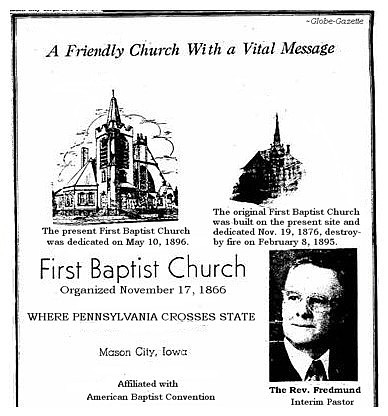
KNIGHTS OF COLUMBUS

From left standing are: Tom L. Connor, whose membership goes back
41 years; H. C. Determan, 35 year member; and Dennis Collins, in the organization 48 years. Seated are initiates
John Pritchard, Clem Hebel and Jerry Harrer. Council 1006 was granted its charter in 1904. Of the charter members
only two are known to be living in this vicinity. Daniel Durken of Mason City and B. J. Kearney of Clear Lake.
At present [1953] the council has 447 members. More than 100 new and reinstalled members joined the council the past
year. NOTE: Thomas L. "Tom" Connor was born in 1892, and died in 1963, interment made at Elmwood-St.
Joseph Cemetery.
BETHEL BAPTIST CHURCH
[Section 8, Page 14] The Bethel Baptist Church, 2243 20th S.W., serves the community in the West Haven district of the City.
FIRST PRESBYTERIAN CHURCH
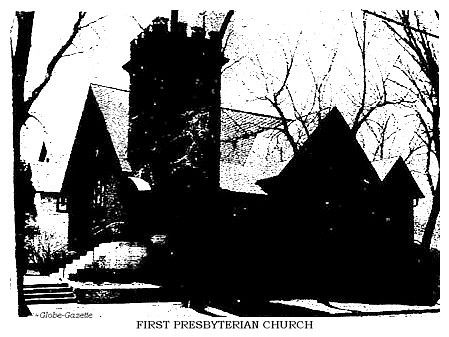
[Section 8, Page 14] The First Presbyterian Church at 9th and Washington N. W., was built in 1908. The
congregation has now acquired a building site in Willowbrook and expects to proceed soon with the construction of a new
church. The First Presbyterian church was organized here in 1905 [under the guidance of the Rev. Crozier] and held its first services in the courthouse.
In 1913 the congregation became self-supporting with a membership of 142. Since then it has undergone substantial
increase in membership. The pastor is Rev. Wilbur F. Dierking. NOTE: Rev. John Crozier came to
Mason City from Oxford, Ohio. There was a Rev. Wilbur Dierking
listed as the interim pastor of The Presbyterian Church of Fairbanks, Alaska, serving from late 1958 to early 1959.
CHURCH OF GOD IN CHRIST
[Section 8, Page 14] The Church of God in Christ, 818 Jackson S. W., has served the community for
many years. The congregation was started in 1923 and in 1928 the property was acquired. The present pastor is the Rev. R.
C. Cottman.
CENTENNIAL MASS
[Section 8, Page 15] Solemn High Mass will be celebrated in the Holy Family Church June 14 as Mason
City's Centennial week closes. An invitation has been sent to the Rt. Rev. Msgr. Maurice Sheehy of the Catholic University
of Washington to be the celebrant. Msgr. Sheehy is a former Holy Family parishioner. The Rt. Rev. Msgr. William B. Green
of Dubuque, editor of the Witness, will deliver the sermon.
CHURCH WORK WAS STARTED HERE IN 1855
[Section 8, Page 15] The organization which developed into the First Congregational Church in Mason City
started holding religious services here in 1855, a year after the arrival of John McMillin and his family. The community
was served by the Rev. Thomas Tenney of Plymouth, who as missionary of the American Home Missionary Society, contacted a
number of the early settlements of that period. As there was no church building previous to 1868, services were held in
homes, McMillin's store and afterwards at the old stone school and the old courthouse. Many of the services appeared to have
been held in a schoolhouse, three miles north of Mason City on the banks of the Winnebago River. This building was
afterwards purchased by the members and enlarged as a chapel. On Sept. 4, 1868, the congregation completed a small stone
building, which is still a part of the church plant. The cost of the building as it then stood was $4,294, the entire amount
of which was raised by subscription except for $500 donated by the Congregational Union. In 1871 a belfry and spire was
erected at a cost of $500. Early pastors who served the congregation included the Revs. Thomas Tenney, S. La Due,
James D. Mason, James B. Gilbert, William P. Bennett, Newton F. Blakeslee, E. C. Moulton and James R. Knodel. The first
members were Nathiel Adams, Emma Adams, Charles M. Adams, Simon Van Patter, L. J. Huntley, Lucy Temple, Elizabeth Dibble,
Jane E. Gardner, T. Greene and Eleanor Florence.
NAZARENE CHURCH ORGANIZED IN 1929
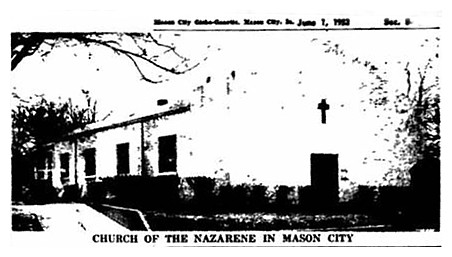
The Womens Foreign Missionary
Society was organized in 1929 with the following serving as officers: Mrs. Wiggins, president; Mrs. DeVoll, vice president;
Mrs. Logue, recording and corresponding secretary; Mrs. Soule, superintendent of study and publicity; and Mrs. Bartholmen
[Bartholmew?],
treasurer. Acting ministers since organization are: M. E. DeVoll, R. Wiggins, F. H. Enoch, the Rev. Fritzaln, Lester
Kindred, Ralph Kaldenberg, the Rev. Minor, W. A. Pace, Merle Dimbath, E. O. Davis and the present pastor, Paul A. Madden.
NOTE: Lemuel Clarence Scobee was born July 30, 1875, Stahl, MO, and died September 4, 1949, Elmira, MO.
His wife, Laura Edith (Headrick) Scobee, was born November 11, 1878/9, Mason City, and died July 1940, Cherokee, Iowa.
They were interred at Elmwood-St. Joseph Cemetery.
OUR SAVIOR'S LUTHERAN CHURCH
The interior of the sanctuary is finished in light oak. The chancel furniture, made by the men of the congregation, is
constructed of oak and finished in semi-blond. Four pairs of laminated arches support the roof. The ceiling is
constructed of car-siding stained a light brown and laid over 4 by 4 exposed rafters. The church, built during the
pastorate of the Rev. Joel Dobbe, was dedicated in June, 1950.
BULLETIN BOARD HONORS SERVICEMEN
Photographs courtesy of Globe-Gazette unless otherwise noted Some of the photographs did not scan well. In such a case the photograph has been substituted with a clearer copy if available. Transcriptions and Notes by Sharon R. Becker, December of 2014 & January of 2015 Information obtained in notes from cemetery transcriptions, obituaries, biographies & other Globe-Gazette articles
|
Return to Centennial Church Index Page Return to Mason City Centennial Index Page Return to History Index Page Return to Cerro Gordo Home Page